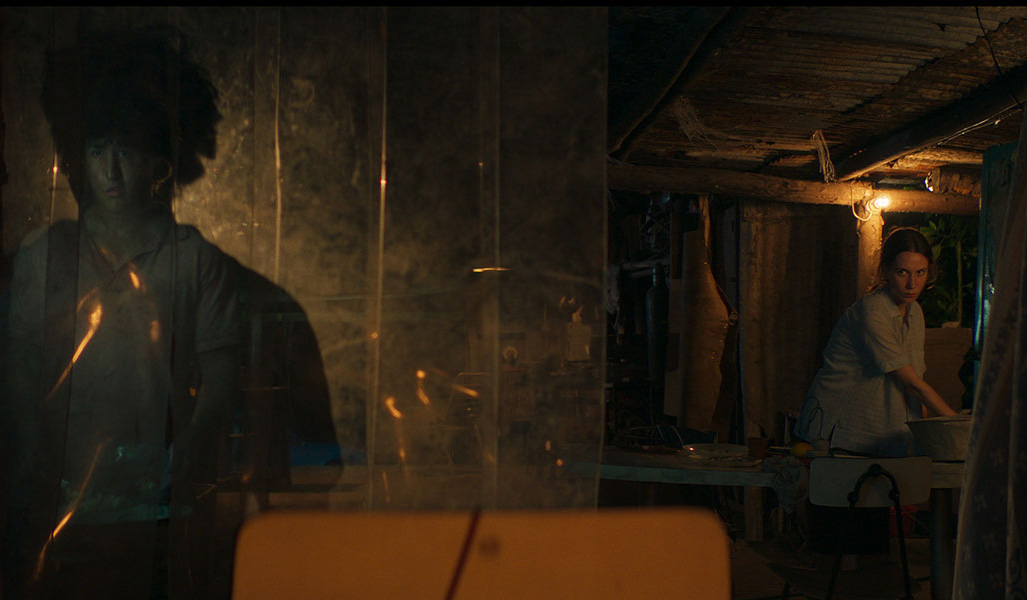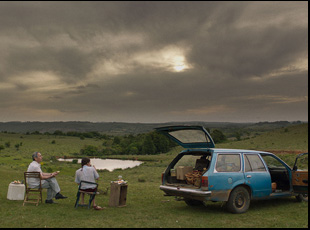More things look to be broken than fixed when Reverend Pearson (Alfredo Castro) and his teenage daughter Leni (Almudena Gonzalez) arrive at the garage of a mechanic named Gringo (Sergi Lopez) in “A Ravaging Wind,” their only option for car repair for miles when traveling between churches in the South American countryside as the Protestant priest works as a faith healer. Gringo lives with his son Chango (Joaquín Acebo), who he’d rather not mention when he was deformed from birth, and the relationship the Reverend has with his daughter seems just as distance when he’s made it into one largely built around business as she’s become responsible for the administrative duties of his practice, duplicating tapes of his sermons and making his stops in small towns where he takes center stage go off without a hitch. If a freak mishap with the car has brought them together, it comes to seem like destiny when Leni and Chango can start to see a bit of themselves in one another in spite of the radically different backgrounds they come from.
Writer/director Paula Hernández may be returning to territory she found so fertile before in her 2019 drama “The Sleepwalkers” by adapting Selva Almada’s novel with co-writer Leonel D’Agostino, finding another story of knotty family ties after digging deep into an increasingly unhealthy mother-daughter relationship but she takes things somewhere entirely new as the Reverend and Leni wait for repairs and have the wheels fall off of the machine they’ve built together, making money peddling the word of God when there isn’t a whole lot of pure Christianity between them. A storm is brewing well before clouds form overhead and with an evocative use of bold colors throughout, there’s the feeling that light is always threatening to break through as both Leni and Chango start to recognize how their lives have been shaped by their fathers and the ways in which they might step out of their considerable shadows and come into their own.
If Hernández has specialized in stories of those who struggle to find their voice in a world seemingly intent on silencing them, “A Ravaging Wind” is further proof that her own has become resonant and clearly defined with emotions always stirring under the surface in places that may seem quiet and amongst characters who may appear content to stay in the background yet are just waiting to come to the fore. That underlying tension makes her latest film simmer until its brought to a boil and after recently exploding at the Toronto Film Festival where it made its world premiere, the filmmaker spoke with the help of a translator about how she first got excited about the film, finding a strange and perfectly surreal location to set the story in and how it made for a more difficult but rewarding shoot.
It’s an adaptation of the novel of the same name by a fairly well-known Argentinian author, and the [producers] offered me [the opportunity to] work with absolute freedom and this novel had many of the themes that I’m interested in. It’s a similar family universe as “The Sleepwalkers,” but there were also different themes — religion and rural life, other things that I hadn’t worked on, so it was a challenge. I wanted to think about how mothers are portrayed in absence in this film, and then focusing on fathers who were very strict and forceful about how they think life is. I am always interested in thinking about how children grow up when one has parents – and in this case, there are two [sets of] parents, who are so heavy. How much possibility is there of them finding themselves in a universe where it seems like there is no escape?
The idea of tapes, and how it leads to Leni being introduced to music, is a fascinating one. Was that part of the original novel?
There is a cassette in the story. In the novel, she listens to music by herself and it’s her own private world. That’s one of the few places of freedom for herself. Her father is not very aware of what she listens to and she doesn’t really care that much and in the novel, she shares the music with the character Chango and I decided that this would work in the film in a different way.
What sold you on these actors to play your central quartet?
From the beginning, the producers wanted to work with international actors, but it was very clear from the start that just because you’re international that you’re going to make the cut, so the list was very short. I already knew Alfredo and his body of work, and his very wide range, but he has a very emotional approach to character building. We had to do a huge amount of work because it’s a difficult character, not only because of how he handles himself, but also because of the way he [speaks] when he had the public speech, but also the private family speech, which is very different, only with his daughter. So that was brought into account for the beginning.
And then Sergi is an actor I always liked because he has a cinematic force in his silences and he’s a very physical actor. It was interesting to how to use this presence and physical and it was very important to work with the silences as well, the things that he kept for himself. His timing is also very important. Then with Almundena and Joaquin, it was a long process that took a few months. We rehearsed a lot with them, and there was a coach working with them, because it was almost their first work, but they were great. It was something that I had the intuition during the casting that they could do it.

For me, the word has to be on point when it reaches the actors, but when the bodies begin to have life, you begin to see a back and forth with those actors and how those bonds are created. The bodies are present, so the physicality becomes very important and I was interested in working with them separately and they contribute their own imagination and sometimes it coincides with the characters, sometimes not. You have to have the clarity to take them where they need to go. It’s a very meticulous construction work.
Geography becomes so important to the story. Did you had this location in mind or find one that would fit your idea for this?
It was clear that the film had to be a journey and everything was shot on location, but in different areas of Uruguay. That’s why the landscape literally changes because there are different locations and you can feel it. The idea was that there were quite deserted territories, with dirt roads, close to a border, places where many cultures and languages converge and it’s more of a liminal place. When we were shooting in the north, it was a street on the border between Uruguay and Brazil, and you crossed the street in one country [and you’d enter the other]. So it’s very strange when you feel that about the people that live there but go to school other country and it’s a mixture of a lot of things and it was interesting working on that. The same with the time [it’s set in], which is in the 90s, and maybe you can see a cassette or the model of the car, but you have the windmills [alongside the road]. That’s from now. It’s the future. I didn’t want to be very precise and fix it in a specific particular time or place.

This is my fourth film with my cinematographer [Iván Gierasinchuk] and we have a lot of empathy in our way of thinking. [Iván] is very involved in the narrative that needs to be created through lighting. So there were two initial ideas. One had to do with the idea of religious sculpture, how they are framed and how the picture is made. And then the other had to do with the horror genre and that’s where the bold colors come in. The reds and blacks are very powerful. It was also very interesting and challenging and an opportunity to work all the lens in very carefully because it’s like a very landscape-oriented movie, but the characters are central, so there will have to be constant changes of lenses to place the characters within the landscapes.
Was there a particularly difficult day of filming?
It was many hours of filming, a lot of traveling, and difficult scenes. It was very demanding physically, emotionally, and narratively and there was wind all the time, and dust, animals, rain, cars and motorcycles that didn’t run. We were stopped by a big storm at one point. and [one day] I arrived to the set, and everything was set in place, and then [we] had to walk almost an hour just for the baptism scene. Being in a very remote location made it very difficult.

Of course, I had a vision of the world, which is mine, but not in a closed way. I wanted to open up to each of you. For me, it’s always something that’s completed with the viewer’s gaze. I don’t like movies that end with a closed knot. I like movies with questions and without a [strongly] defined ending where it’s all pointed out, [like] “This is what happens. This is exactly everything.” There’s a lot of excitement showing the picture, but you have [those] loose ends where you can complete it yourself in a way. You have to ask yourself questions as an audience.
“A Ravaging Wind” does not yet have U.S. distribution. It will next play at the San Sebastian Film Festival on September 22nd at the Kursaal 2 at 4:30 pm and Principe 3 at 8:15 pm and September 23rd at Antiguo Berri at 4:30 pm and the Principe 10 at 7:45 pm and 10 pm.





